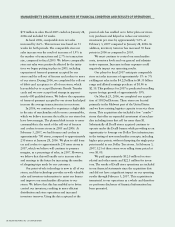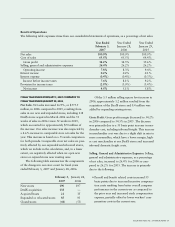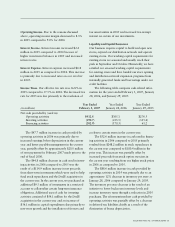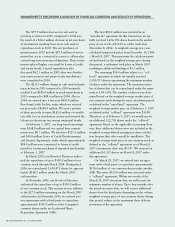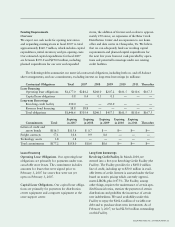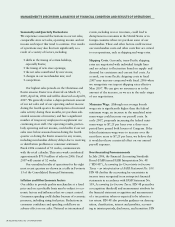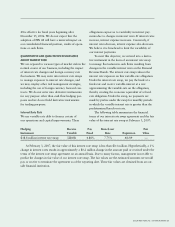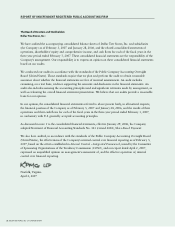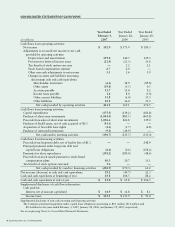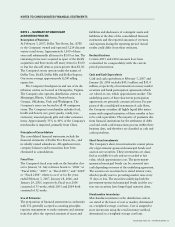Dollar Tree 2006 Annual Report Download - page 26
Download and view the complete annual report
Please find page 26 of the 2006 Dollar Tree annual report below. You can navigate through the pages in the report by either clicking on the pages listed below, or by using the keyword search tool below to find specific information within the annual report.
Seasonality and Quarterly Fluctuations
We experience seasonal fluctuations in our net sales,
comparable store net sales, operating income and net
income and expect this trend to continue. Our results
of operations may also fluctuate significantly as a
result of a variety of factors, including:
• shifts in the timing of certain holidays,
especially Easter;
• the timing of new store openings;
• the net sales contributed by new stores;
• changes in our merchandise mix; and
• competition.
Our highest sales periods are the Christmas and
Easter seasons. Easter was observed on March 27,
2005, April 16, 2006 and will be observed on April 8,
2007. We generally realize a disproportionate amount
of our net sales and of our operating and net income
during the fourth quarter. In anticipation of increased
sales activity during these months, we purchase sub-
stantial amounts of inventory and hire a significant
number of temporary employees to supplement our
continuing store staff. Our operating results, particu-
larly operating and net income, could suffer if our net
sales were below seasonal norms during the fourth
quarter or during the Easter season for any reason,
including merchandise delivery delays due to receiving
or distribution problems or consumer sentiment.
Fiscal 2006 consisted of 53 weeks, commensurate
with the retail calendar. This extra week contributed
approximately $70.0 million of sales in 2006. Fiscal
2007 will consist of 52 weeks.
Our unaudited results of operations for the eight
most recent quarters are shown in a table in Footnote
13 of the Consolidated Financial Statements.
Inflation and Other Economic Factors
Our ability to provide quality merchandise at a fixed
price and on a profitable basis may be subject to eco-
nomic factors and influences that we cannot control.
Consumer spending could decline because of economic
pressures, including rising fuel prices. Reductions in
consumer confidence and spending could have an
adverse effect on our sales. National or international
MANAGEMENT’S DISCUSSION & ANALYSIS OF FINANCIAL CONDITION AND RESULTS OF OPERATIONS
events, including war or terrorism, could lead to
disruptions in economies in the United States or in
foreign countries where we purchase some of our
merchandise. These and other factors could increase
our merchandise costs and other costs that are critical
to our operations, such as shipping and wage rates.
Shipping Costs. Currently, trans-Pacific shipping
rates are negotiated with individual freight lines
and are subject to fluctuation based on supply and
demand for containers and current fuel costs. As
a result, our trans-Pacific shipping costs in fiscal
2007 may increase compared with fiscal 2006 when
we renegotiate our import shipping rates effective
May 2007. We can give no assurances as to the
amount of the increase, as we are in the early stages
of our negotiations.
Minimum Wage. Although our average hourly
wage rate is significantly higher than the federal
minimum wage, an increase in the mandated mini-
mum wage could increase our payroll costs. In
early 2007, proposals increasing the federal mini-
mum wage to $7.25 per hour over a three-year
period have passed both houses of Congress. If the
federal minimum wage were to increase over the
next three years to $7.25 per hour, we believe that
it would not have a material effect on our annual
payroll expenses.
New Accounting Pronouncements
In July 2006, the Financial Accounting Standards
Board (FASB) issued FASB Interpretation No. 48
(“FIN 48”), Accounting for Uncertainty in Income
Taxes – an interpretation of FASB Statement No. 109.
FIN 48 clarifies the accounting for uncertainty in
income taxes recognized in an enterprise’s financial
statements in accordance with FASB Statement No.
109, Accounting for Income Taxes. FIN 48 prescribes
a recognition threshold and measurement attribute for
the financial statement recognition and measurement
of a tax position taken or expected to be taken in a
tax return. FIN 48 also provides guidance on derecog-
nition, classification, interest and penalties, account-
ing in interim periods, disclosures, and transition. FIN
24 DOLLAR TREE STORES, INC. • 2006 ANNUAL REPORT




